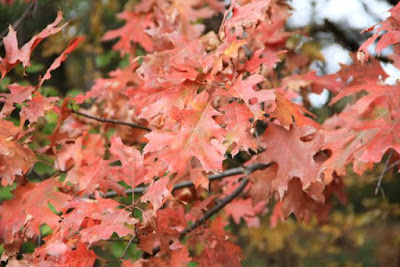 |
| tamaracks turned golden
Photo by J. Harrington
|
Although the tamaracks have all turned golden, we're in the midst of another warmer than average Autumn day. I've been having trouble getting geared up for bread baking and soup eating season. Not that I'm complaining, but I've lived in Minnesota long enough to have assimilated the fear that better than normal weather gets paid for one way or another. To be honest, it's possible I brought this perspective with me from New England and found that Minnesota just reinforced it.
 |
| copper-scarlet oak leaves
Photo by J. Harrington
|
I remember reading a while ago that climatologists, meteorologists or folks like them have defined periods of record on which they base their definitions of "average." For example, the current U.S. Climate data for St. Paul covers the 30-year period from 1981 to 2010, but we know that weather records go back much further in time than 1981. Without knowing what's being used as a baseline, I find comparisons are difficult to understand, especially since we know that we live on an earth and in a universe that are constantly changing. Our phenological(?) observations clearly don't incorporate the time(s) when Minnesota was partially covered by glaciers, but we know that such has occurred several times in our multi-billion year past. We've been trading species with other continents since long before the St. Lawrence Seaway was completed, and seem quite concerned about losing our honeybee populations, despite the fact that honeybees aren't indigenous to North America.
 |
| copper and bronze oak leaves
Photo by J. Harrington
|
Much of what set off today's comments can be attributed to the fact that this year's oak leaves seem much more colorful than "normal." But I realize that that may be because of this past Summer's weather or that last Autumn's oak leaves spent much time over the Winter hanging on the branches after they'd turned boring brown. I didn't remember the baseline established by last year's photos, just as, if we do have a "La Nina" Winter, it will be a real challenge to remember how much we enjoyed this extended period of warm Autumn days. These warm days also make it hard to get motivated to take the snow blower in for its annual physical, before it's really needed, rather than after it's too late.
Falling Leaves and Early Snow
By Kenneth Rexroth
In the years to come they will say,“They fell like the leavesIn the autumn of nineteen thirty-nine.”November has come to the forest,To the meadows where we picked the cyclamen.The year fades with the white frostOn the brown sedge in the hazy meadows,Where the deer tracks were black in the morning.Ice forms in the shadows;Disheveled maples hang over the water;Deep gold sunlight glistens on the shrunken stream.Somnolent trout move through pillars of brown and gold.The yellow maple leaves eddy above them,The glittering leaves of the cottonwood,The olive, velvety alder leaves,The scarlet dogwood leaves,Most poignant of all.In the afternoon thin blades of cloudMove over the mountains;The storm clouds follow them;Fine rain falls without wind.The forest is filled with wet resonant silence.When the rain pauses the cloudsCling to the cliffs and the waterfalls.In the evening the wind changes;Snow falls in the sunset.We stand in the snowy twilightAnd watch the moon rise in a breach of cloud.Between the black pines lie narrow bands of moonlight,Glimmering with floating snow.An owl cries in the sifting darkness.The moon has a sheen like a glacier.
********************************************
Thanks for visiting. Come again when you can.
Please be kind to each other while you can.
No comments:
Post a Comment